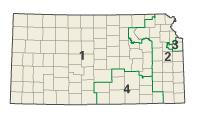
Kansas Congressional Districts
Encyclopedia
Following the 2000 Census, the U.S state of Kansas
neither gained nor lost seats in the United States House of Representatives
, retaining its four seats (and six electoral votes). Redistricting
was most recently completed by the Kansas Legislature
in 2002.
Historically, Kansas has been apportioned
a greater number of seats in the House of Representatives.
The number of congressional seats decreased from five to four following the 1990 Census. Historically, the state has held as many as eight seats (1893–1933). The State is expected to lose its fourth seat following the 2020 or 2030 Census.

lines. The Governor
has veto power over the plan.
For the 2000 reapportionment process, the guidelines adopted by the House Select Committee on Redistricting and the Senate Committee on Reapportionment (April 25–26, 2001) were as follows:
The "community of interests" was further defined as "social, cultural, racial, ethnic, and economic interests common to the population of the area, which are probable subjects of legislation". It was suggested that the core of the existing districts should be preserved, and, because of their importance as political or socioeconomic units, whole counties should be in the same district to the extent possible.
Kansas
Kansas is a US state located in the Midwestern United States. It is named after the Kansas River which flows through it, which in turn was named after the Kansa Native American tribe, which inhabited the area. The tribe's name is often said to mean "people of the wind" or "people of the south...
neither gained nor lost seats in the United States House of Representatives
United States House of Representatives
The United States House of Representatives is one of the two Houses of the United States Congress, the bicameral legislature which also includes the Senate.The composition and powers of the House are established in Article One of the Constitution...
, retaining its four seats (and six electoral votes). Redistricting
Redistricting
Redistricting is the process of drawing United States electoral district boundaries, often in response to population changes determined by the results of the decennial census. In 36 states, the state legislature has primary responsibility for creating a redistricting plan, in many cases subject to...
was most recently completed by the Kansas Legislature
Kansas Legislature
The Kansas Legislature is the state legislature of the U.S. state of Kansas. It is a bicameral assembly, composed of the lower Kansas House of Representatives, composed of 125 Representatives, and the upper Kansas Senate, with 40 Senators...
in 2002.
Historically, Kansas has been apportioned
United States congressional apportionment
United States congressional apportionment is the process by which seats in the United States House of Representatives are redistributed amongst the 50 states following each constitutionally mandated decennial census. Each state is apportioned a number of seats which approximately corresponds to its...
a greater number of seats in the House of Representatives.
The number of congressional seats decreased from five to four following the 1990 Census. Historically, the state has held as many as eight seats (1893–1933). The State is expected to lose its fourth seat following the 2020 or 2030 Census.

Legislative responsibility
In Kansas the state legislature has initial responsibility for drawing the congressional districtCongressional district
A congressional district is “a geographical division of a state from which one member of the House of Representatives is elected.”Congressional Districts are made up of three main components, a representative, constituents, and the specific land area that both the representative and the...
lines. The Governor
Governor of Kansas
The Governor of the State of Kansas is the head of state for the State of Kansas, United States. Under the Kansas Constitution, the Governor is also the head of government, serving as the chief executive of the Kansas executive branch, of the government of Kansas. The Governor is the...
has veto power over the plan.
For the 2000 reapportionment process, the guidelines adopted by the House Select Committee on Redistricting and the Senate Committee on Reapportionment (April 25–26, 2001) were as follows:
- Kansas counties and voting districts were the "building blocks" used for drawing district boundaries, using their population reported in the 2000 U.S. Decennial Census as the basis.
- Districts were to be as nearly equal to 672,105 population as practicable, but would attempt to recognize "community of interests".
- Redistricting plans would have neither the purpose nor the effect of diluting minority voting strength.
- Districts would be as compact as possible and contiguous.
The "community of interests" was further defined as "social, cultural, racial, ethnic, and economic interests common to the population of the area, which are probable subjects of legislation". It was suggested that the core of the existing districts should be preserved, and, because of their importance as political or socioeconomic units, whole counties should be in the same district to the extent possible.

